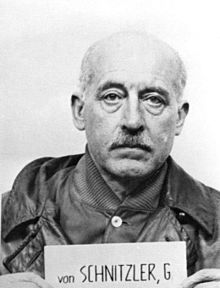Georg von Schnitzler

Georg August Eduard Schnitzler , von Schnitzler since 1913 (born October 29, 1884 in Cologne , † May 24, 1962 in Basel ) was a board member of IG Farben and a convicted war criminal .
Life
Schnitzler came from a respected Cologne entrepreneur and banker family. His father was Paul von Schnitzler , his mother Fanny Emilie, née Joest (1861–1941). His uncle Richard von Schnitzler was a partner in the Cologne bank JH Stein and a member of the supervisory board of the paintworks Meister Lucius and Brüning in Höchst am Main . The brothers were raised to the Prussian nobility in 1913 .
After attending school in Cologne, Schnitzler studied law in Bonn , Leipzig and Berlin ; In 1903 he joined the Corps Palatia Bonn . In 1906 he was a trainee lawyer, in 1907 he received his doctorate . He then completed practical training at the JH Stein bank and, like his father, joined the Hoechst company in 1912.
From 1910 he was married to Lilly von Mallinckrodt , who distinguished herself as an art patron, especially for the painter Max Beckmann .
From 1914 to 1918 he was deployed as a soldier at the front during World War I , until in 1919 he became an authorized signatory at the Hoechst company . Appointed a deputy board member in 1920, he soon became head of paint sales until he was elected a full board member in 1924. In this post he worked in 1925 when drafting the merger agreements for the IG Farben Group , of which he was a board member between 1926 and 1945. In 1929 Schnitzler was appointed Reich Commissioner for the World Exhibition in Barcelona .
He was a participant in the secret meeting on February 20, 1933 . In 1934 he joined the SA and over time achieved the rank of Hauptsturmführer . He was also a member of the German Labor Front . In 1937 he joined the NSDAP. In 1937 he was transferred as manager of the IG Farben administration building in Frankfurt am Main ; In 1942 he was military economic leader and in 1943 chairman of the chemicals committee.
Schnitzler was also a member of various supervisory boards and Vice President of the Court of Arbitration of the International Chamber of Commerce .
Schnitzler's crimes in World War II include the exploitation of French and Polish chemical plants in order to secure the supremacy of IG Farben in Europe . That is why he was sentenced to five years' imprisonment in the I.G. Farben trial in Nuremberg on July 30, 1948, from which he was released early from the Landsberg war crimes prison in 1949, taking into account his pre- trial detention. Schnitzler, of 1950 for the Catholic faith converted , after the war President of the German-Ibero-American Society.
Schnitzler was buried in the family grave of his wife Lilly at the Melaten cemetery in Cologne (HWG No. 105/106).
literature
- Jens Ulrich Heine: Verstand & Schicksal: The men of IG Farbenindustrie AG (1925-1945) in 161 short biographies. Weinheim, Verlag Chemie, 1990. ISBN 3-527-28144-4 .
- Ernst Klee : The dictionary of persons on the Third Reich . Fischer, Frankfurt am Main 2007. ISBN 978-3-596-16048-8 . (Updated 2nd edition)
- Rolf Rieß (ed.): Lilly von Schnitzler - Carl Schmitt. Correspondence from 1919 to 1977. In: Schmittiana. Contributions to the life and work of Carl Schmitt. New series, Vol. 1, Berlin 2011, pp. 113–256.
- Ulrich S. Soénius: Schnitzler. In: New German Biography (NDB). Volume 23, Duncker & Humblot, Berlin 2007, ISBN 978-3-428-11204-3 , p. 332 f. ( Digitized version ).
- Hermann Weiß (Ed.): Biographical Lexicon for the Third Reich . S. Fischer, Frankfurt am Main 1998, ISBN 3-10-091052-4 .
Web links
- Federal Archives on G. v. Schnitzler Reichstag files on this
- Wollheim Memorial - Biography of Georg von Schnitzler
- Newspaper article about Georg von Schnitzler in the 20th century press kit of the ZBW - Leibniz Information Center for Economics .
Individual evidence
- ↑ Kösener Corpslisten 1930, 14 , 607
- ↑ a b c d e Hermann Weiß (Ed.): Biographisches Lexikon zum Third Reich , 1998, p. 411f.
- ^ Ernst Klee : The dictionary of persons on the Third Reich. Who was what before and after 1945 . Fischer Taschenbuch Verlag, Second updated edition, Frankfurt am Main 2007, ISBN 978-3-596-16048-8 , p. 554.
| personal data | |
|---|---|
| SURNAME | Schnitzler, Georg von |
| ALTERNATIVE NAMES | Schnitzler, Georg August Eduard; Schnitzler, Georg August Eduard von |
| BRIEF DESCRIPTION | German industrialist |
| DATE OF BIRTH | October 29, 1884 |
| PLACE OF BIRTH | Cologne |
| DATE OF DEATH | May 24, 1962 |
| Place of death | Basel |
